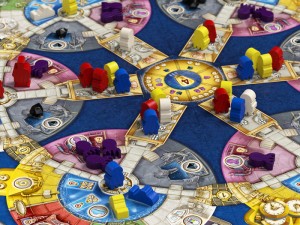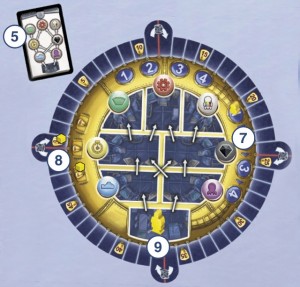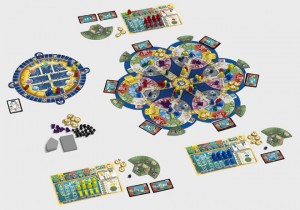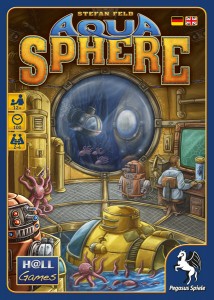Spiel 2014 Preview: Aquasphere
Posted by James (admin) on August 19th, 2014
 Those of you that have read my blog for a while will know I’m always interested in Stefan Feld’s games as I like how he uses interesting game mechanics. One of his releases this year is Aquasphere which is on the complex end of the scale.
Those of you that have read my blog for a while will know I’m always interested in Stefan Feld’s games as I like how he uses interesting game mechanics. One of his releases this year is Aquasphere which is on the complex end of the scale.
If you see a picture of it, the game looks incredibly complicated but it’s actually relatively simple as far as the mechanics go – it will be working out how to make best use of your actions (as well as doing so whilst other players get in the way) that will be the trickiest part.
The game is set in an underwater base comprised of 6 sectors which each have 7 coloured sections (1 for each type of action). Each player has an engineer who programs their bots, bots that carry out pre-programmed actions, a scientist who determines where the bots carry out their actions, and some submarines. Each player has a player board where their bots and subs are placed, as well as a lab which is where their items are stored (with strict limits). On your turn, you either program one of your bots, carry out an action with a programmed bot, or pass.

This is the headquarters where players move their engineers to program their bots.
Programming a Bot
Each round, your engineer starts at the bottom of the headquarters. When you want to program a bot, you move your engineer to the next space in the headquarters section (which each show a specific action) and then place one of your bots on the matching action on your player board to show what it is programmed to do. (You can only have 2 programmed bots at any time and they must have different actions programmed.)
The extra tricky part here is that your engineer has limited choices which space they can move to next as they must follow the arrows between the spaces. This means they can not reach every combination of actions; plus, your engineer only makes one pass through the headquarters each round meaning they will only enter 3 spaces.
The actions that can be programmed in each space are changed each round too, so the order they appear in changes too (see the card in the top-left of the headquarters image which shows the layout of the actions for the round). However, you can spend time tokens to allow you to program anything you want, and there is an action that allows a bit to programmed too.
Taking an Action with a Bot
When you use a bot to take an action, it does so in the sector where your scientist is located. Before taking the action, you can move your scientist to a different sector (potentially costing time to do so). Then, you move your programmed bot from your player board to the centre of the sector and perform the relevant action. (Bots in the centre of a sector can earn Victory Points (VPs) at the end of a round, and each newly arrived bot displaces any previous bot which goes to a loading bay.)
The different programmed actions allow you to:
- Expand your lab by taking new piece next to sector where action is performed (increases number of items you can hold)
- Take time markers (used for various things)
- Take crystals (scoring you VPs between rounds)
- Catch octopods (scoring you instant VPs)
- Place a submarine (costing time markers but scoring VPs)
- Take the research card next to sector where action is performed (giving you special abilities)
- Program a bot (to perform one specific action)
At the end of each of the 4 rounds, there is an intermediate scoring phase with VPs based on things like total bots in play and total crystals. The board is then prepared for the next round by adding new research cards, lab expansions, crystals, octopods, etc. After 4 rounds, there is an end of game scoring as well based on things like the mix of pieces in your lab (player board), submarines placed, etc.
Thoughts
As you can probably see, it’s a relatively simple process of programming bots to take actions but programming the right actions at the right time with your scientist in the right sector is going to take some mental juggling. Also, other players may have taken the crystals, lab expansion, research card, etc. from the sector where you were going to do the same before you get there. Plus, you need to work out how to make your actions worth VPs during the game in order to win.
I do like the sound of Aquasphere. It definitely looks complex but it’s got the potential to be a really good meaty euro and with a very unusual core game mechanic.
You can read the game details on Hall Games’ website using this link: bga.me/aquasphere
For more Spiel 2014 previews, check out my Spiel 2014 Previews page which lists the games on my radar with links to their previews too.
James.



